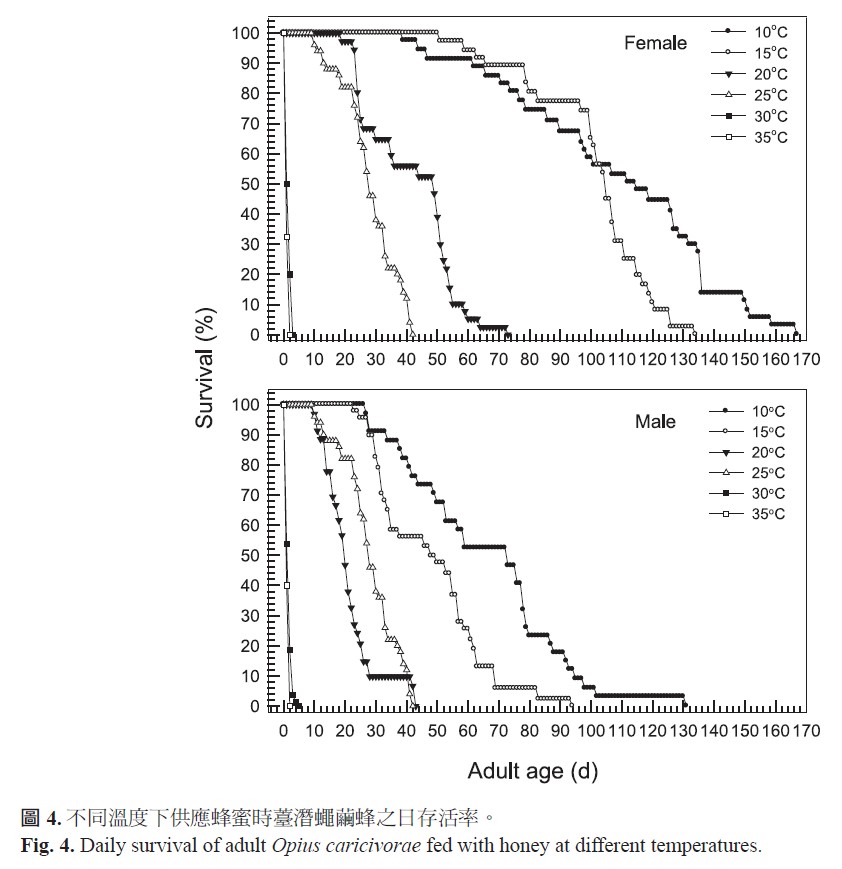All issues
Author:Ching-Chin Chien* and Shu-Chen Chang
Abstract:
The objective of this study was to determine effect of host and temperature on population increase and parasitism of the wasp, Opius caricivorae Fischer, using two species of hosts, Liriomyza huido-brensis (Blanchard) and Liriomyza sativae Blanchard, and six temperatures (10, 15, 20, 25, 30 and 35℃). The time required for the development of the wasp at different stages varied with host species. Using L. huidobrensis as host, the development period of wasps from egg to pupal stage was 82.6 days at 10℃ and 15.5 days at 25℃ and the survival rate was 62.6% at 10℃, 79.2–91.2% at 15℃ to 25℃ and 0% at 30℃. Using L. sativae as host, the development period of wasps from egg to pupal stage was 81.0 days at 10℃ and 11.4 days at 30℃ and the survival rate was 52.5% at 10℃, 85.8–89.0% at 15℃ to 25℃ and 67.4% at 30℃. The low temperature threshold for development of the wasp was 7.03 and 7.61℃ from egg to pupal stage on the hosts L. huidobrensis and L. sativae, respectively. The accumulated heat units required for development of the wasp was 40, 88, 36, 125 and 286 degree-days for egg, larval, prepupal, pupal and egg to pupal stage, respectively, on the host L. huidobrensis, whereas the accumulated heat units required for development of the wasp was 36, 83, 31, 112 and 263 degree-days for egg, larval, prepupal, pupal and egg to pupal stage, respectively, on the host L. sativae. The lifetime fertility of the wasp was 10, 156, 146 and 259 wasps at 10, 15, 20 and 25℃, respectively, on L. huidobrensis and was 18, 171, 257, 277 and 216 wasps at 10, 15, 20, 25 and 30℃, respectively, on L. sativae. Depending on L. huidobrensis and L. sativae, the intrinsic rate of increase (rm) of female wasps was 0.1874 and 0.2223/day, net reproductive rate (Ro) was 116.413 and 152.113 female wasps/female, and mean generation time (T) was 25.38 and 22.60 days at 25℃, respectively. When adult wasps were provided with honey only without host from 10℃ to 35℃, the maximum longevity of the female and male wasps was 108.4 and 66.2 days at 10℃, respectively. For wasps provided daily with both hosts (L. sativae) and honey, the maximum longevity of female wasps was 34.3 days at 20℃, and male wasps was 53.6 days at 10℃. This study indicates that O. caricivorae was an effective parasitoid of L. huido-brensis and L. sativae when the temperature was at 15–25℃ and 15–30℃, respectively.
Key words:Opius caricivorae, Liriomyza huidobrensis, Liriomyza sativae, Temperature, Population increase
Download:![]() PDF Links
PDF Links
- 1. Development of Tractor-Mounted Seedling Transplanter for Sweet Potato
- 2. Synergistic Effect of Additional Gas on the Toxicity of Phosphine to Sitophilus oryzae and Sitophilus zeamais (Coleoptera: Dryophthoridae)
- 3. Effects of Temperature and Solar Radiation on Growth Traits and Plant Elements in Purple Leafy Sweet Potato

 Submit your manuscript
Submit your manuscript
 Guide for authors
Guide for authors